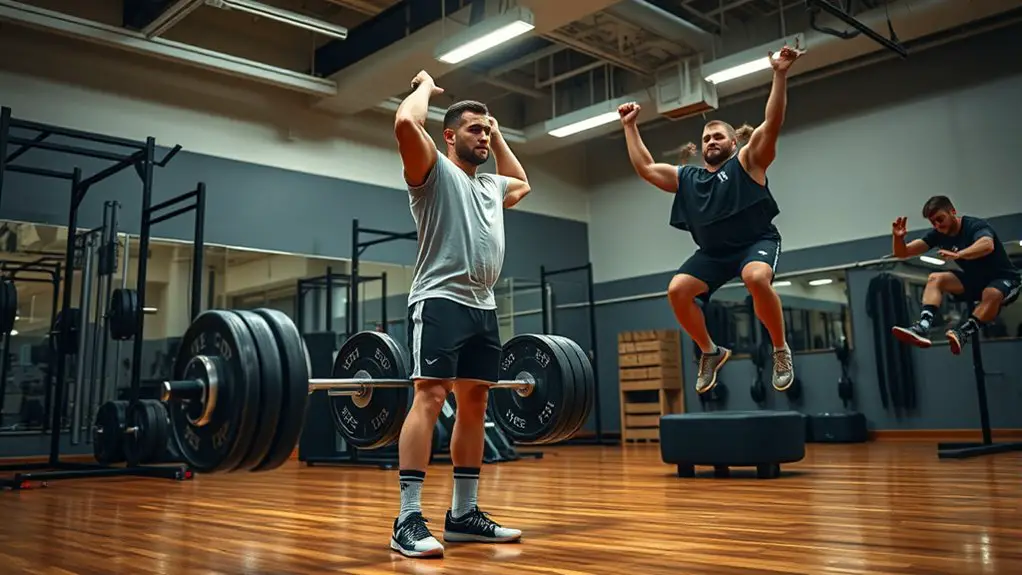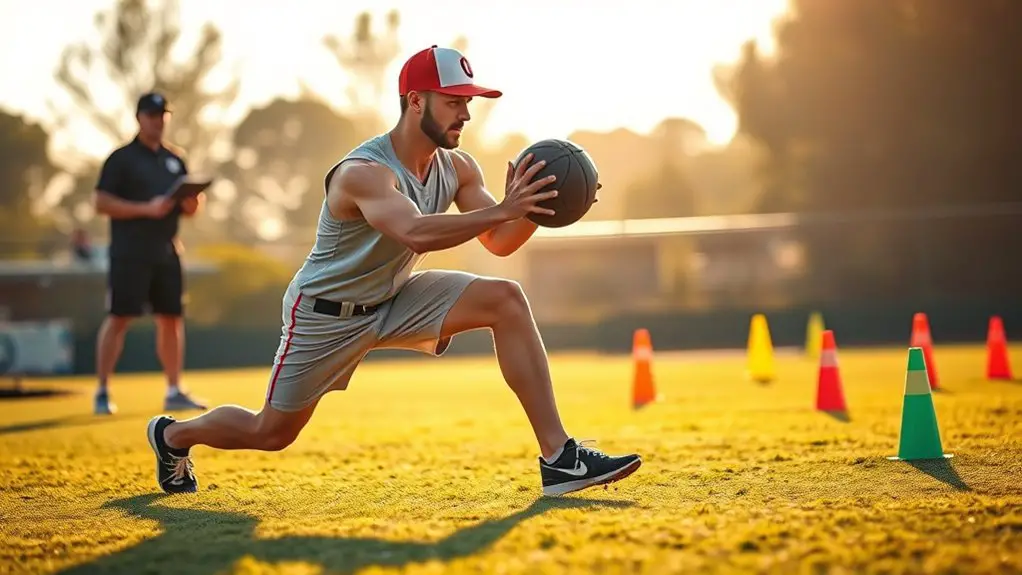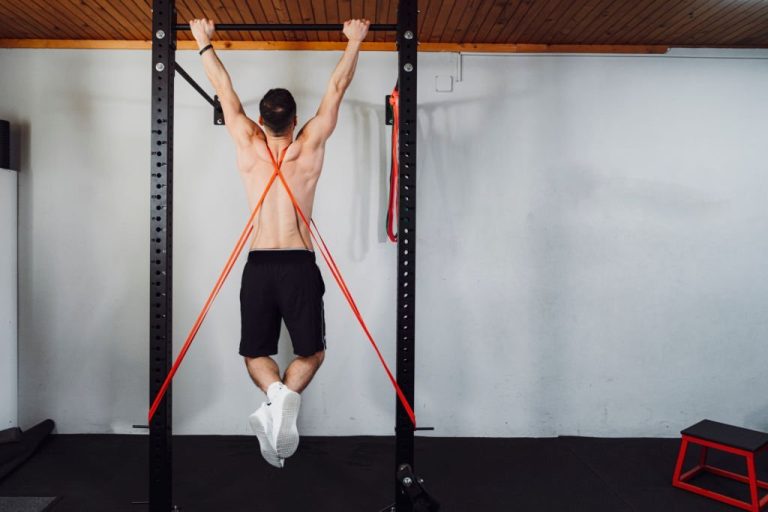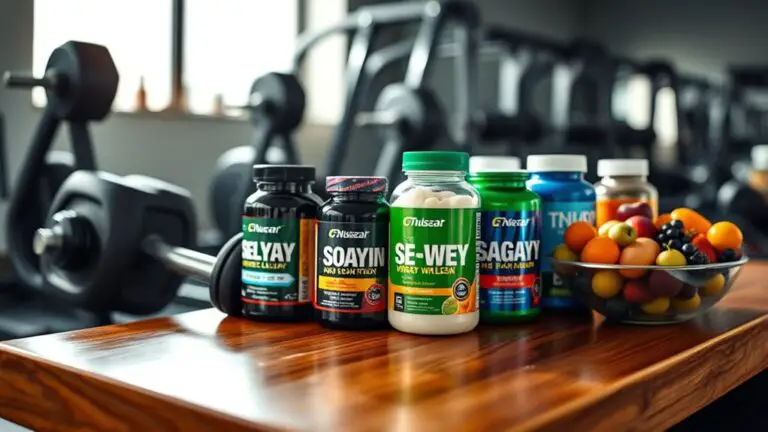The Best Strength Exercises for Baseball Players

To enhance your baseball performance, focus on upper body exercises like the bench press and pull-ups for strength and power. Don’t neglect your lower body with squats and deadlifts, which are essential for driving force in your swings. Core stability from planks and Russian twists is crucial for balance and injury prevention. Incorporating plyometrics can boost your explosiveness, while flexibility and mobility workouts guarantee you stay agile and injury-free. There’s so much more you can explore!
Upper Body Strength Exercises

When it comes to baseball, having a strong upper body is vital for improving your performance on the field. Strengthening your upper body not only enhances your batting and throwing power but also helps prevent injuries. Two effective exercises you should incorporate into your routine are the bench press and pull-ups.
The bench press targets your chest, shoulders, and triceps, making it a key exercise for developing explosive upper body strength. Always use a spotter or safety bars to guarantee you’re lifting safely and avoid injury.
Pull-ups are another fantastic exercise for building upper body strength, focusing on your back, biceps, and shoulders. They’re great for improving grip strength, which is essential for controlling the bat and throwing the ball accurately.
Lower Body Strength Exercises
Building upper body strength is important, but don’t overlook the significance of lower body strength in baseball. A solid foundation can enhance your performance, from running the bases to generating power in your swing. Incorporating squat variations and deadlift techniques into your training routine can help develop those essential leg muscles.
Here’s a quick overview of effective lower body exercises:
| Exercise | Description | Safety Tips |
|---|---|---|
| Squat Variations | Front squats, goblet squats | Keep your back straight |
| Deadlift Techniques | Conventional, sumo deadlifts | Maintain a neutral spine |
| Lunges | Forward, reverse lunges | Step straight, avoid twisting |
Core Stability and Strength

Core strength is vital for baseball players, as it enhances your stability and power during swings and throws. Without a strong core, you’re more prone to injuries and less effective on the field. Let’s explore some effective core exercises to help you build that essential strength.
Importance of Core Strength
A strong core acts as the foundation for any athlete, especially for baseball players who rely on stability and power during their performance. Core strength benefits go beyond just looking fit; it plays a vital role in maintaining balance and preventing injuries. When you have a stable core, you’re better equipped to handle the twists and turns of the game, allowing for more precise movements. This enhanced stability directly contributes to enhancing athletic performance, whether you’re pitching, hitting, or fielding. Furthermore, a strong core supports efficient energy transfer during dynamic actions, which is essential for maximizing your potential on the field. Prioritizing core strength not only boosts your game but also helps guarantee you stay safe and healthy while playing.
Effective Core Exercises
To enhance your performance on the field, incorporating effective core exercises is essential. A strong core supports your movements, improves stability, and enhances rotational strength, which is crucial for hitting and throwing. Start with planks to build core engagement; they stabilize your entire body. Progress to Russian twists, which target your obliques and promote rotational strength. Medicine ball throws are another excellent choice, as they mimic the explosive movements used in baseball. Always focus on maintaining proper form to prevent injury. Incorporate these exercises into your routine, ensuring you balance strength with flexibility. By prioritizing core stability, you’ll not only improve your game but also decrease the risk of injuries as you push your limits on the field.
Plyometric Training for Explosiveness
As you aim to enhance your performance on the field, incorporating plyometric training can greatly boost your explosiveness. These plyometric techniques focus on developing your ability to generate power quickly, essential for explosive movements like sprinting, jumping, and swinging.
Consider these key benefits of plyometric training:
- Increased speed: Feel the thrill as you dash to first base faster than ever.
- Improved power: Experience the satisfaction of hitting the ball with more force.
- Enhanced agility: Enjoy the freedom of moving swiftly around the diamond.
To safely integrate these exercises, start with basic drills like box jumps or squat jumps, ensuring your form is correct to avoid injury. Gradually increase intensity and complexity as your body adapts. Remember, the goal is to build strength while maintaining your safety, setting you up for success on the field.
Flexibility and Mobility Workouts

Flexibility and mobility are key components of your training that can greatly enhance your performance on the field. Incorporating dynamic stretching techniques and specific mobility drills not only prevents injuries but also improves your overall athleticism. Let’s explore how these workouts can benefit your game.
Importance of Flexibility
While many athletes focus on strength and conditioning, overlooking flexibility can lead to missed opportunities for performance enhancement and injury prevention. To elevate your game, incorporating flexibility benefits into your routine is essential. Utilizing effective stretching techniques can increase your range of motion, allowing for smoother movements on the field.
- Improved balance and coordination
- Reduced risk of injuries during play
- Enhanced recovery after intense workouts
Dynamic Stretching Techniques
Dynamic stretching techniques play an essential role in preparing your body for the demands of baseball. These dynamic warm-ups, which include movements like leg swings, arm circles, and torso twists, help to increase blood flow and flexibility while reducing the risk of injury. Incorporating active stretching into your routine engages your muscles, promoting better range of motion and overall performance. Focus on controlled movements that mimic the actions of baseball, allowing your body to adapt to the dynamic nature of the sport. Remember to start slowly and gradually increase intensity to guarantee safety. By prioritizing these dynamic stretching techniques, you not only enhance your flexibility but also set yourself up for a successful and injury-free game.
Mobility Drills for Performance
After warming up with dynamic stretching techniques, it’s time to focus on mobility drills that enhance your performance on the field. Incorporating these exercises not only boosts your dynamic mobility but also plays an essential role in injury prevention.
- You’ll feel more agile and responsive during games.
- Improved flexibility can lead to better swings and throws.
- Staying injury-free means more time on the field doing what you love.
Consider integrating hip openers, thoracic rotations, and ankle mobility drills into your routine. These workouts help maintain joint health and improve overall movement efficiency. Remember, prioritizing mobility isn’t just about performance—it’s about keeping your body safe and ready for each play.
Sport-Specific Strength Drills
To excel in baseball, incorporating sport-specific strength drills into your training regimen is vital. These drills target the unique movements and muscle groups you rely on during games, helping you build strength while minimizing injury risk. Focus on exercises like rotational medicine ball throws, which enhance your core strength for powerful swings and throws.
Using resistance bands for lateral movements can improve your agility and stability, essential for fielding and base running. Remember, safe execution is key—always start with lighter weights to guarantee proper form before progressing.
Frequently Asked Questions
How Often Should Baseball Players Strength Train Each Week?
When it comes to strength training frequency, you should aim for about 2 to 3 sessions per week. This allows your muscles to recover adequately between workouts, which is essential for preventing injuries. It’s important to listen to your body; if you’re feeling fatigued, don’t hesitate to take an extra rest day. Balancing your training with proper recovery will help you build strength effectively while keeping you safe on the field.
What Is the Best Warm-Up Routine Before Strength Workouts?
Before your strength workouts, it’s essential to warm up properly. Start with dynamic stretching to get your muscles ready and increase blood flow. Focus on movements like leg swings and arm circles. Incorporate mobility exercises to enhance your range of motion, helping prevent injuries. A good routine might last 10-15 minutes, ensuring you feel energized and safe as you shift into more intense strength training. Remember, a proper warm-up is key to performance.
Are There Specific Dietary Recommendations to Support Strength Training?
Imagine your body as a finely-tuned machine, needing the right fuel at the right time. To support your strength training, focus on nutrient timing; consume protein intake shortly after workouts to repair and build muscle. Think of it as watering a plant right after a hot day—the nutrients help it thrive. Prioritize whole foods, stay hydrated, and listen to your body’s needs. It’s all about nurturing your engine for peak performance and safety!
Can Strength Training Help Prevent Baseball Injuries?
Yes, strength training can greatly help with injury prevention. By building stronger muscles, tendons, and ligaments, you’re reducing the risk of strains and sprains that often occur during baseball. The strength benefits you gain not only enhance your performance but also promote better body mechanics, leading to safer movements on the field. Incorporating a well-structured strength program can be a smart choice to keep you healthy and performing at your best.
How Can Players Track Their Strength Training Progress Effectively?
To track your strength training progress effectively, you should focus on specific strength metrics like weight lifted, repetitions, and sets. Keeping a detailed log can help you visualize your improvements over time. Consider using apps or spreadsheets to record your sessions, ensuring you stay consistent and safe. Regularly reviewing your progress will not only boost your motivation but also help you identify areas needing adjustment, minimizing the risk of injury as you advance.





